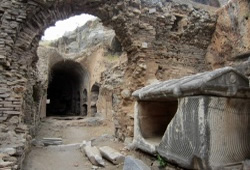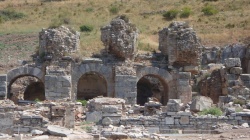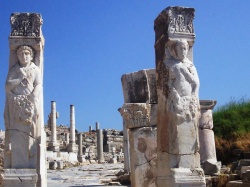The history of Ephesus City goes a long, long way back in time. Based on the legend, Ephesus or also sometimes spelled as Ephesos, was originally founded by the Amazons, a tribe composed of exceptional female warriors. It is said that the city’s name has been taken from "Apasas" which happens to be the name of a certain city belonging to the Kingdom of Arzawa that means “city of the Mother Goddess.” Also, according to several scholars, the labrys sign, the mother goddess’s double axe adorning the palace located at Knossos, Crete, came from Ephesus.
The Birth of Ephesus

Ephesus became the hub of learning and was also the birthplace and home of Heraclitus, the great Pre-Socratic philosopher. The women then were able to enjoy privileges and right similar with the women, with records of female teachers, painters, artists, and sculptors. When night time falls, the city’s streets were brightened by the lit oil lamps, a luxury of those times that cannot be afforded by most cities.
The Construction of Temple of Artemis

Changes Under the Rule of Lysimachus
Ephesus remained under the rule of Persia until Alexander the Great liberated the city in 334 BCE. Upon setting foot on the city and discovering that the Temple of Artemis’s reconstruction was not yet completed, Alexander volunteer to have it rebuilt. However, his offer was refused by the Ephesians, claiming that it does not seem fitting for one god to build another god’s temple. One of Alexander’s generals, Lysimachus who later ruled the region following the death of Alexander, started the city’s development and renewal, which he named Arsineia to commemorate his wife, Arsinoe. Lysimachus constructed a brand new harbor, established defensive walls on slopes of the mountains of Bülbül and Panayir, as well as moved the whole city to about 2 miles to the southwest. However, the Ephesians once again refused the idea of leaving behind their homes and their city’s traditional site. According to the date found on Ephesus history, this made Lysimachus decide to block the sewage system of the city during a great storm which then rendered the Ephesians’ home uninhabitable, thus forcing them to move. The history of Ephesus City was then re-founded, now taking its old name over again, Ephesus, in 281 BCE, and continuing to be among the Mediterranean’s most vital commercial ports.
Under the Roman Empire

There were still many other significant changes that made up Ephesus history before it finally declined both in intellectual and culture pursuits after Christianity became the region’s dominant religion. The city streets that used to be adorned with highly maintained, lighted and statuary oil lamps during night time, turned into darkness and decay as the city’s then Christian citizens have been directed to the Second Coming of the Light of the World, Jesus Christ.


